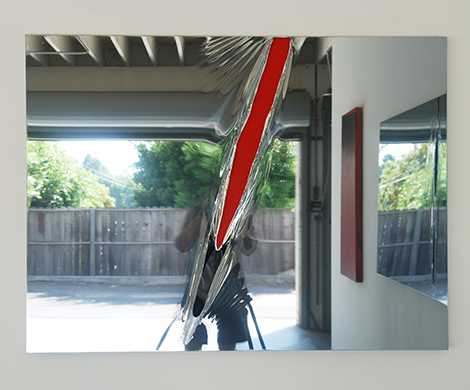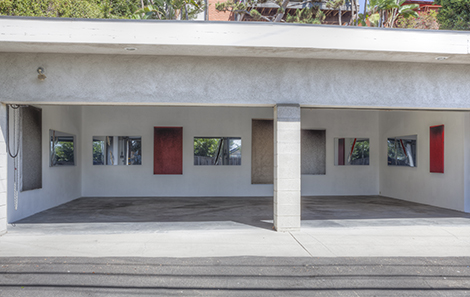John Knuth’s provocative “Base Alchemy” juxtaposes minimal abstractions: tiny specks of dark paint over solid lighter colors; stretched reflective Mylar surfaces torn to reveal predominantly monochromatic backgrounds.
Knuth’s Mylar images pay homage to Lucio Fontana, who began slashing his canvases in the 1950s. Fontana’s gesture was not just an act of violence; it was intended in part to create three dimensional space. Melting the taut, reflective Mylar with signal flares, Knuth inflicts burn wounds upon the work, creating voids in the mirrored surfaces that serve as a respite from the dizzying reflections. In Red Sun Set (2014), the Mylar surface is bisected by a jagged gash revealing a red canvas below.
Facture, destruction and process play important roles in Knuth’s work. He is invested in the alchemic properties and the performance-based aspects of his practice; he indulges in spectacle, often inviting viewers to watch as he creates. Nontraditional materials and methods imbue his works with otherworldliness. His Mylar series, “Sun Set,” references the refraction and glow of the setting sun. Inspired by the disaster-prone Los Angeles context, Knuth uses objects associated with safety as materials for artistic creation. Rather than using Mylar blankets and signal flares as intended, Knuth obfuscates their functionality to create what he calls “sci-fi sunsets.”
The Mylar works are exhibited in conjunction with a series of fly-process paintings. After preparing his surface—first painting it a monochromatic color derived from the tones of the Los Angeles sky—Knuth releases more than 500,000 flies in their larval state within carefully crafted enclosures, constraining their movements to the canvas. The flies hatch and dart across the canvases, eating and then regurgitating a combination of pigment and sugar water. The result is a canvas decorated with diminutive marks akin to a Pointillist painting. Over a few weeks time, the flies cover the canvas from end to end with irregular flyspecks. These specks trace the flies’ paths as they move back and forth across the surface, their density most evident at the edges where the food source is located.
A MOCA TV video, gone viral, focuses on how the works are made, expanding Knuth’s audience. Yet it also caused some to question the possible abuse of the flies. Knuth insists that no harm comes to the animals in the making of the work—the paint is nontoxic—and that his flies have a better life than the normal house fly. Using flies as a tool and blankets and flares as materials, Knuth employs a DIY aesthetic in stretching the boundaries associated with traditional painting, making inventive works in unconventional ways. His methodology adds intrigue, yet after the wow-factor subsides, what remains are attractive and compelling abstractions about texture and surface. Knuth’s works are so minimal that the actions and spectacle of their creation disappear, leaving works that engage with the canon of formalism, adding to the conversation in new and intriguing ways.



